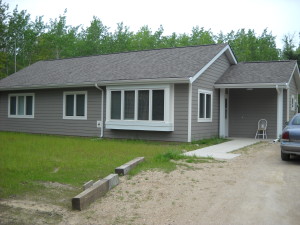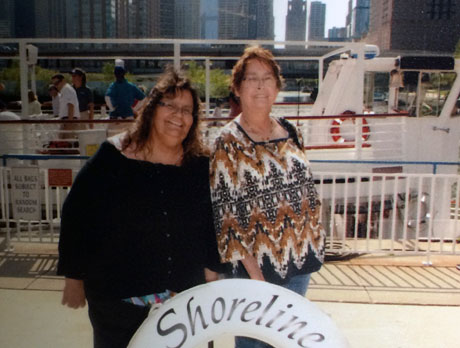The staff members of the Red Lake Reservation Housing Authority of Red Lake, MN, are skilled developers and managers of 247 Low Income Housing Tax Credit (LIHTC) homes that they have built or rehabilitated over the course of 10 completed projects. They have another project in the works, Red Lake 12, which is rehabilitating 40 additional homes. They’ve accomplished so much since they first started with the program in 1996, and Travois Chairman David Bland has been with them since the beginning.
When I asked David about Red Lake, he said: “I often say that Indian housing authorities are the best-run housing authorities in the nation. When you consider the very large public housing authorities like the Minneapolis, or Los Angeles, St. Louis, or Boston housing authorities, people often judge them only on the bad news they hear. Many of those housing authorities have great challenges and do a wonderful job of providing affordable housing for the poorest urban families. But none have the challenges nor the inadequate funding that Indian housing authorities function under every day.
“When you consider the Red Lake Reservation Housing Authority, consider an organization that continues year in and year out to provide decent and affordable housing in perhaps the harshest weather in the nation, for some of the lowest income households in the nation, and they do it with a depressingly small budget. I can say without hesitation that it is the best-managed housing authority I have ever come across, Indian or non-Indian, and I have been doing this for nearly 40 years (I am really old).”
If you’ve heard of the Red Lake Reservation Housing Authority, you’ve undoubtedly also heard the names of Jane Barrett, executive director, and Linda McGraw-Adams, assistant executive director, who have provided the critical leadership and guidance to create this housing. I recently spoke to Linda to get her views on their experiences with the LIHTC program, why it is critical for Red Lake and how they manage so many homes and do it so well. (In the photo above, Linda is on the left, and Jane is on the right.)
Q: How did you get started at Red Lake?
A: I have been here since 1995. I came in working in resident services, working with low-rent tenants and doing housing inspections. I did that for a year and a half. When we started the tax credit program, I took over the leasing of the properties, and I moved to the lease compliance position. I held that position for 5 years. After that, I was appointed as the assistant executive director. Our LIHTC division consists of LIHTC manager, our leasing specialist and our inspector and three maintenance people.
Q: How many families or individuals would you estimate have lived in these homes?
A: We have 247 homes. We don’t have very high turnover. On Red Lake 1, we’ve had three turnovers. On Red Lake 2, we’ve had two turnovers. The people that are in the homes have stayed in the homes. On Red Lake I, one person took employment out of state. On the second turnover, one person had an illness and passed away… The third one, there was a fire in the unit, and it was due to the tenants not taking care of the units. We selected a new tenant.
The tenants have been steady in there. They’re not moving out. They want to stay in the homes, and they take really good care of them.
[Linda said at minimum, the homes have served 250 families, and the average family size is 3 to 5 family members.]
Q: How did Red Lake get started with the LIHTC program and what do you still want to accomplish?
A: After Jane [Barrett] came in as our director when NAHASDA [the Native American Housing Assistance and Self-Determination Act] was enacted. NAHASDA gave the housing authorities the ability to leverage our funds.
David Bland came into our office to discuss the Low Income Housing Tax Credit program and met with our staff, the housing board and tribal council. The tribal council thought that the housing authority board and staff should do it. Jane and the housing board were visionaries, and they saw what this could do to our housing stock and use the money three times over. That was one of the good aspects of the tax credit program.
It is a lot of work. The paperwork is really voluminous, but we’ve done it. We’ve never regretted doing any of the tax credits projects. Red Lake 12 is a rehab project of our CAS {current assisted stock] of our rental units, so that’s the first time we’re doing that.
We’re looking at doing another tax credit project perhaps in 2016. We have ready sites in the Red Lake District and Redby District that we need to fill. We’re looking at doing more tax credits. After that project, I don’t know if we’ll do anymore. I don’t plan on retiring ever. They’re just going to have to wheel me out of here.
You can’t please everyone all the time. But a lot of times you have tenants who are really happy with what we are doing, and they are willing to do their part and comply with what we need to have them do. That’s always a good thing — where everyone is on the same page, and we’re all working toward the same goal.
Q: What are some of the challenges you have overcome working with the Low Income Housing Tax Credit program?
A: A lot of the initial lease-up and getting people into the homes and getting it across to the people – this is not a low-rent unit. There are different rules for these types of units. I always tell the new tenants – I’m going to tell you this right off the bat – the first few years we are going to be very intrusive. We are going to be inspecting, investors will be inspecting, the state of Minnesota, and there may be other inspectors to look at the unit. If that’s something that you aren’t comfortable with, then maybe this program isn’t for you. Getting them used to getting all of the paperwork we need all the time — that was one of the hardest things. It’s been going well. We just have to take our firm stand and follow through.

Q: What advice do you have for other tribal housing authorities who may be thinking of getting involved with the Low Income Housing Tax Credit program?
A: One of the main things I had to keep going over is to make sure that the individuals who are going through the units are income-qualified at move-in. That’s one of the things – stick to your income guidelines. The tenants only have to be income-qualified at initial move-in.
We have quite a few tenants who have moved up in their employment since they moved in. Now they are established in their career, maintained their position, their income has gone up. Or when they came in, there may have only been one income, and once the children are old enough to be alone, the other partner could take employment. Or one partner has completed school and since gained employment.
—
Stay tuned for Part 2 of the interview! Linda will talk about why more housing is needed at Red Lake and will share stories of two families who have benefited from safe, affordable housing.


